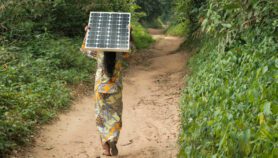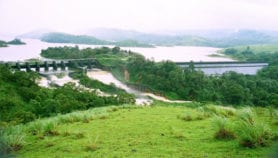By: Crispin Maslog
Send to a friend
The details you provide on this page will not be used to send unsolicited email, and will not be sold to a 3rd party. See privacy policy.
More Asia–Pacific countries need to embrace renewable energy and follow the first tentative steps of some governments, says Crispin Maslog.
The South-East Asia and Pacific region is blessed with abundant sources of 'green' energy — including sun, wind, water, biomass and geothermal — but governments are still not doing enough to harness them.
The 30 countries in this part of the world are sitting just a few degrees below and above the equator, and enjoy an estimated 300 days of sunshine a year. Advances in photovoltaic (PV) technology mean that solar energy can be harnessed even on cloudy days during the rainy season.
There are signs that renewable energy, particularly solar, is slowly being promoted in the region. Indonesia, Malaysia, the Philippines and Thailand are among countries leading the way.
These South-East Asian countries have adopted the necessary policies to attract domestic and international investment in renewable energy. Government-led initiatives include 'feed-in tariffs', which provide payments to small-scale green energy producers; customs and duty exemptions for energy companies; and guaranteed access to the electricity grid.
Harnessing the sun
Thailand is the first country to encourage investment in large-scale solar power parks. It has just completed the Solarta 3MW Sai Sena Solar Park in Ayutthaya, 70 kilometres north of Bangkok, a model project for the region.[1]
The park produces 4,471 megawatt hours of clean energy each year — enough to power 1,530 homes. Thailand is aiming for renewable energy to contribute a quarter of the country's total energy mix by 2022.
Malaysia jumped on the solar energy bandwagon by introducing nonfinancial support mechanisms such as standardising contracts between electricity providers and buyers (power purchase agreements), and by investing in infrastructure to provide grid access.
Malaysia has set a target for 2,080 megawatts or 11 percent of all electricity generated in 2020 to come from solar and other renewable sources.
Government takes a lead
Indonesia, on the other hand, has taken a slightly different route. There, the government announced last year that it is directly investing in solar energy by building communal solar power plants on 100 small islands across the country, to be followed by 1,000 more on other islands the following years. The plants will channel electricity to households in poor areas nearby.
The islands project will cost the government 900 billion Indonesian rupiah (around US$94 million) and will be implemented by Indonesia's national electricity utility PT PLN. In addition to the island programmes, PT PLN has announced that it will provide 340,000 rural households in eastern Indonesia with small solar systems, which represents a total investment of around US$139 million. [2]
Government initiatives are at the forefront of renewable energy provision in the Philippines too. In 2008, the country launched a National Renewable Energy Program (NREP) which aims to increase the country's renewable energy capacity — including solar energy — from 5,400 megawatts to 15,300 megawatts in 2030.
Most of the solar energy projects now operating in the country are in remote rural areas — for example, the Alliance for Mindanao Off-grid Renewable Energy Program (Amore) has been providing electricity to off-grid towns since 2002, using renewable energy sources such as solar and small-scale hydropower.
Amore is also contributing towards the government's goal of achieving 90 per cent household electrification by 2017. To date, it has energised more than 12,000 households in 400 of Mindanao's 13,000 barangays (villages). [3]
The solar energy movement is also taking hold in the Pacific islands, particularly Papua New Guinea and Palau, through the Pacific Islands Renewable Energy Project (PIREP) and the Pacific Islands Greenhouse Gas Abatement through Renewable Energy Project (PIGGAREP), which promote the commercialisation of renewable energy technologies.
Not a cheap option
Even though the renewable energy industry has reduced its costs by between 15 and 20 per cent every year on average over the past ten years, renewable energy remains more expensive than building a fossil-fuelled power plant. [2]
This is a major barrier for promoting green energy, and investment is lagging in some countries in the region. Vietnam, for example, has huge renewable energy resources, but has not yet taken advantage of this potential because of the huge funds required to construct infrastructure such as solar parks and power grids.
Solar power projects in the country therefore depend on foreign investment, meaning that solar technology tends to be restricted to state agencies and institutions.
To encourage investment into the solar power business, governments have to ensure favourable conditions for private entrepreneurs — for example, by mandating utilities to buy power generated from renewable energy sources for a certain period, during which the cost of electricity is fixed.
Other incentives include tax exemptions, duty cuts, investment grants, soft loans, government co-investment schemes and funding for research.
It is time to embrace the sun. These solar and other renewable energy projects are the way countries in South-East Asia and the Pacific must go as they face the prospect of more extreme and frequent storms and droughts associated with climate change.

Crispin Maslog is a Manila-based consultant for the Asian Institute of Journalism and Communication. A former journalist, professor and environmental activist, he worked for the Press Foundation of Asia and the International Rice Research Institute.
References
[1] S.E. Asia urged to exploit abundant clean energy (Agence France Presse, 2011)
[2] Southeast Asia embraces solar power, Singapore International Energy Week (2011)
[3] Solar panels: Embrace the sun to power homes (Philippine Daily Inquirer, 2010)













